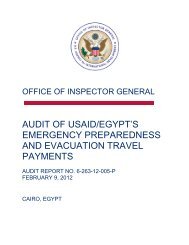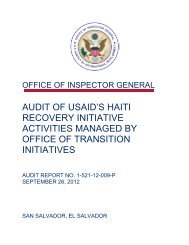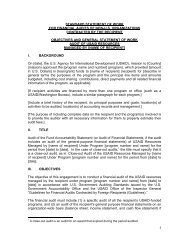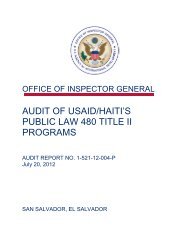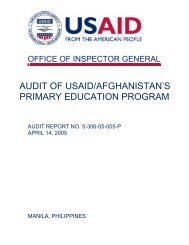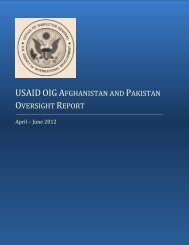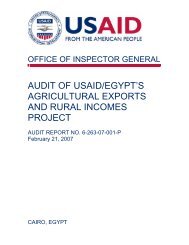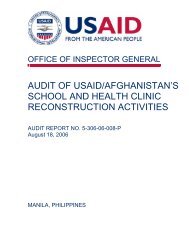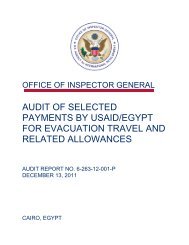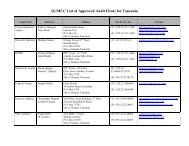Audit of USAID/Egypt's Family Planning Activities - US Agency For ...
Audit of USAID/Egypt's Family Planning Activities - US Agency For ...
Audit of USAID/Egypt's Family Planning Activities - US Agency For ...
Create successful ePaper yourself
Turn your PDF publications into a flip-book with our unique Google optimized e-Paper software.
OFFICE OF INSPECTOR GENERALAUDIT OF <strong><strong>US</strong>AID</strong>/EGYPT’SFAMILY PLANNING ACTIVITIESAUDIT REPORT NO. 6-263-06-001-PSeptember 28, 2006CAIRO, EGYPT
Office <strong>of</strong> Inspector GeneralSeptember 28, 2006MEMORANDUMTO:FROM:SUBJECT:<strong><strong>US</strong>AID</strong>/Egypt Director, Kenneth C. EllisRegional Inspector General/Cairo, David H. Pritchard /s/<strong>Audit</strong> <strong>of</strong> <strong><strong>US</strong>AID</strong>/Egypt’s <strong>Family</strong> <strong>Planning</strong> <strong>Activities</strong>(Report No. 6-263-06-001-P)This memorandum transmits our final report on the subject audit. We have considered yourcomments on the draft report and have included your response in its entirety in Appendix II.This report includes one recommendation to increase oversight by the Activity Manager <strong>of</strong> thefamily planning program. Based on your comments and documentation provided, amanagement decision has been reached for the recommendation. Determination <strong>of</strong> final actionwill be made by the <strong>Audit</strong> Performance and Compliance Division (M/CFO/APC).I appreciate the cooperation and courtesy extended to my staff during the audit.
CONTENTSSummary <strong>of</strong> Results ....................................................................................................... 1Background ..................................................................................................................... 2<strong>Audit</strong> Objective.................................................................................................................. 2<strong>Audit</strong> Findings................................................................................................................. 3Has <strong><strong>US</strong>AID</strong>/Egypt’s family planning program progressed towardsits intended outputs within selected components <strong>of</strong> the program?Many activities needed further progress…..................................................................3Some reported outputs within quarterly progress reportswere not accurate or documented...............................................................................7Evaluation <strong>of</strong> Management Comments ......................................................................... 9Appendix I – Scope and Methodology ........................................................................ 10Appendix II – Management Comments ....................................................................... 12Appendix III – Progress Towards Intended Outputs.................................................. 17
SUMMARY OF RESULTSThe Regional Inspector General/Cairo performed this audit to determine if<strong><strong>US</strong>AID</strong>/Egypt’s family planning program had progressed towards its intended outputswithin selected components <strong>of</strong> the program. (See page 2.)<strong><strong>US</strong>AID</strong>/Egypt’s family planning program progressed as intended for 29 <strong>of</strong> 59 activitiestested during the last two quarters <strong>of</strong> calendar year 2004 and the first two quarters <strong>of</strong>calendar year 2005. (See page 3.) <strong>For</strong> the items tested, the program successfullyimplemented a broad range <strong>of</strong> planned activities that emphasized youth, gender, andsustainability issues that improved the lives <strong>of</strong> recipients through such initiatives as:• provision <strong>of</strong> family planning training to religious leaders,• promotion <strong>of</strong> family planning and reproductive issues on radio and television,• establishment <strong>of</strong> the popular Shabab Tahseen Week for youth, and• creation <strong>of</strong> a national pharmacy and physician electronic consultation database.(See page 3.)Nonetheless, the program has not met the planned progress for 30 <strong>of</strong> the 59 activitiestested, primarily because <strong>of</strong> insufficient monitoring <strong>of</strong> the project's progress and fundingcuts. In addition, the program implementer’s quarterly reports did not accurately reportor document outputs in 21 instances. (See page 7.) As a result, we recommend that theDirector, <strong><strong>US</strong>AID</strong>/Egypt, increase oversight <strong>of</strong> the measurement, evaluation, andachievement <strong>of</strong> the approved objectives <strong>of</strong> the family planning program. (See page 8.)In its response to our draft report, <strong><strong>US</strong>AID</strong>/Egypt stated that the Mission had awarded acontract for an integrated reproductive health services project in order to increase thelevel <strong>of</strong> management control over the contractor. The Cognizant Technical Officer willinstitute guidance that will ensure the linkage <strong>of</strong> all quarterly reports to annual workplans,and the linkage between projected activities and actual results. Under the contract, theMission plans to document all significant changes affecting the new project throughamendments to the award. (See page 16) Therefore, we consider that a managementdecision has been reached on the recommendation. Appendix II containsmanagement’s comments in their entirety (without attachments).1
AUDIT FINDINGS<strong><strong>US</strong>AID</strong>/Egypt’s family planning program progressed as intended for 29 <strong>of</strong> 59 plannedactivities tested for the period from July 1, 2004, until June 30, 2005. This program,through the Catalyst Project, undertook a broad range <strong>of</strong> planned activities thatemphasized youth, gender, and sustainability issues. <strong>For</strong> example, among the 29planned activities that showed progress as intended, the Catalyst Project:• provided health education to family members and underserved communities throughdirect contacts, workshops, and printed materials;• trained 103 teachers in Minia Governate to provide health education and literacyclasses to communities;• established a National Youth Hotline in January 2005 to provide accuratereproductive health information to Egyptian youth;• trained 120 male and female religious leaders to increase family planning andreproductive health knowledge in three governates;• worked alongside media pr<strong>of</strong>essionals to promote family planning and reproductiveissues through articles and television and radio programs;• produced, in collaboration with the trained media pr<strong>of</strong>essionals, 25 radio and 19television programs aimed at teens and young adults in Upper Egypt;• established the popular event, Tahseen’s Shabab 2 Week, in conjunction with schoolsand communities;• partnered with non-government organizations and commercial entities; and• established and expanded an Ask/Consult national electronic database <strong>of</strong>pharmacies and physicians.However, as discussed below, half <strong>of</strong> the activities needed to make better progress. Inaddition, the Catalyst Project quarterly progress reports to <strong><strong>US</strong>AID</strong>/Egypt did notaccurately report or document outputs in 21 instances.Many <strong>Activities</strong> Needed Further ProgressSummary: The annual <strong><strong>US</strong>AID</strong>-approved workplans encompassing the last twoquarters in calendar year 2004 and the first two quarters <strong>of</strong> calendar year 2005projected the completion <strong>of</strong> 117 activities. Of 59 activities tested, the programshowed progress in only 29, primarily because <strong>of</strong> insufficient monitoring <strong>of</strong> theproject's progress and funding cuts. As a result, the lack <strong>of</strong> progress and theunapproved changes jeopardized the achievement <strong>of</strong> sustainable progress setforth in the original planning for the components <strong>of</strong> the project tested.The annual <strong><strong>US</strong>AID</strong>-approved workplans encompassing the last two quarters in calendaryear 2004 and the first two quarters in calendar year 2005 projected the completion <strong>of</strong>117 planned activities. Of the 59 activities tested, the program, through the CatalystProject, showed progress in 29 <strong>of</strong> them. However, the program had not progressedtowards its intended outputs in 30 <strong>of</strong> 59 planned activities tested. Specifically, 6 <strong>of</strong> 182 Shabab means “youth.”3
youth activities, 14 <strong>of</strong> 24 non-governmental organization sector activities, and 10 <strong>of</strong> 17commercial sector activities had not progressed toward intended outputs.Youth <strong>Activities</strong>—We reviewed 18 <strong>of</strong> 50 (36 percent) youth activities listed in theCatalyst Project’s approved workplans for the last two quarters in calendar year 2004and the first two quarters in calendar year 2005. The Catalyst Project progressedtowards intended outputs for 12 <strong>of</strong> the 18 youth activities (67 percent). Following aresome examples <strong>of</strong> the six activities that had not progressed towards intended outputs:• The Project dropped plans to complete a curriculum for youth-friendly services due tobudget constraints.• Budget constraints led to suspension <strong>of</strong> plans to provide training and technicalassistance for a peer educator program at Minia University.• The Project intended to establish several youth clinics at Egyptian universities, butdue to budget constraints, it suspended plans to do so.Appendix III, Table 1, shows the status <strong>of</strong> progress for all 18 youth activities.Non-Governmental Organization <strong>Activities</strong>—We reviewed 24 <strong>of</strong> 32 (75 percent)non-governmental organization activities listed in the Catalyst Project’s approvedworkplans for the last two quarters in calendar year 2004 and the first two quarters incalendar year 2005. The Catalyst Project progressed towards intended outputs for 10(42 percent) <strong>of</strong> the 24 non-governmental organization sector activities. Following aresome examples <strong>of</strong> the 14 activities that had not progressed towards intended outputs:• <strong><strong>US</strong>AID</strong> agreed to fund plans to assess the capacity <strong>of</strong> the Ministry <strong>of</strong> Health andPopulation’s Non-Governmental Health Unit and help it to expand its role. However,the project missed its target dates and did not perform the assessment.• To further collaboration among the different working groups <strong>of</strong> the Ministry <strong>of</strong> Healthand Population and the Ministry <strong>of</strong> Insurance and Social Affairs, the project plannedto conduct four meetings. However, the meetings were not held because theMinistries’ representatives were not available.• Project activities included linking non-governmental organizations with non-healthprograms <strong>of</strong> national and international organizations by identifying programs andestablishing alliances based on mutual interests. This was not accomplished due tothe lack <strong>of</strong> interest shown by the organizations.Appendix III, Table 2, shows the status <strong>of</strong> progress for all 24 non-governmentalorganization sector activities.Commercial <strong>Activities</strong>—We reviewed 17 <strong>of</strong> 35 (49 percent) commercial activities listedin the Catalyst Project’s approved workplans for the last two quarters in calendar year2004 and the first two quarters in calendar year 2005. The Catalyst Project progressedtowards intended outputs for 7 <strong>of</strong> the 17 commercial sector activities (41 percent). Thefollowing are examples <strong>of</strong> the 10 activities that had not progressed towards intendedoutputs:• The Project initially planned to link family planning community workers to selectedpharmacies for social marketing purposes. However, the Project dropped thisactivity because the Ministry <strong>of</strong> Health and Population did not grant its approval dueto lack <strong>of</strong> involvement by physicians and pharmacists.4
• The Project explored the possibility <strong>of</strong> making large pharmacies into stockists, orstorage places, for small pharmacies. The Project dropped the activity afterdetermining it was more suitable for another ongoing <strong><strong>US</strong>AID</strong> project.• The Project developed plans to conduct two national pharmacy audits <strong>of</strong>contraceptives and reproductive health and maternal child health products.However, because the audits were outside the Catalyst Project’s mandate, theMission authorized the transfer <strong>of</strong> this activity to another <strong><strong>US</strong>AID</strong> project.Appendix III, Table 3, shows the status <strong>of</strong> progress for all 17 commercial sectoractivities.* * * * *As described, the program, through the Catalyst Project, had not progressed towardsintended outputs for 30 <strong>of</strong> the 59 activities tested. As shown in Appendix III, the threeprimary causes for this were:• insufficient monitoring by Mission staff to measure and evaluate recipient progress,• budget constraints for 14 activities, and• 4 activities being transferred or deemed more suitable for other <strong><strong>US</strong>AID</strong> projects,<strong><strong>US</strong>AID</strong> <strong>of</strong>ficials said that they monitored the project implementers through emails, verbal,and telephonic communications on a regular basis. Nevertheless, they needed toperform additional monitoring steps. Specifically, <strong><strong>US</strong>AID</strong> <strong>of</strong>ficials needed to (1) analyzethe linkages between the annual workplans and quarterly reports and (2) documentapproval <strong>of</strong> changes to workplans.<strong><strong>US</strong>AID</strong> project <strong>of</strong>ficials told us that they did not handle a lot <strong>of</strong> formal documentation butwere aware <strong>of</strong> some differences between the workplans and what had been achieved asreported in the quarterly reports. Furthermore, the Activity Manager was aware <strong>of</strong>changes to the workplans made by the Catalyst Project implementers. However, thePopulation and Health Office did not document <strong>of</strong>ficial changes to the annual workplans.Automated Directives System 202.3.6.3 urges the making <strong>of</strong> adjustments to programs incoordination with the Agreement Officer when necessary or when conditions warrant.Furthermore, according to Automated Directives System 202.3.6, outputs are critical toachieving results.In addition to insufficient monitoring, during the period audited, budget constraintsaccounted for 14 <strong>of</strong> the 30 activities lacking progress. According to Mission <strong>of</strong>ficials, thelack <strong>of</strong> progress occurred primarily because <strong>of</strong> funding cuts, which led to changes inplanned activities.The Catalyst Project was part <strong>of</strong> a larger Population and Health portfolio consisting <strong>of</strong>many more hundreds <strong>of</strong> millions <strong>of</strong> dollars that were subject to adjustment by<strong><strong>US</strong>AID</strong>/Washington. In fact, <strong><strong>US</strong>AID</strong>/Washington <strong>of</strong>ficials made the decision to cutProject funding. A responsible Catalyst <strong>of</strong>ficial told us that because <strong>of</strong> these fundingcuts, the implementers focused available resources on previously established activitiesand community mobilization activities. The Catalyst Project’s quarterly progress reportswarned that budget constraints would limit the extent <strong>of</strong> the project's capability and someareas would be cut. <strong>For</strong> example, the implementer postponed four quarterly meetingsand a workshop for Government <strong>of</strong> Egypt ministries’ non-governmental organizations5
committees and 15 training courses for community workers in three governorates andurban poor areas.In commenting on the draft report, the Mission highlighted that even though 30 <strong>of</strong> 59activities did not achieve planned progress for intended outputs, overall project goalswere met (see Management Comments in Appendix II). Even so, the lack <strong>of</strong> progressand the unapproved changes jeopardized the achievement <strong>of</strong> sustainable progress setforth in original planning for the components <strong>of</strong> the project-tested youth activities, nongovernmentalorganization activities, and commercial activities. We have included arecommendation to address insufficient monitoring at the conclusion <strong>of</strong> the followingsection.6
Some Reported Outputs Within Quarterly Progress ReportsWere Not Accurate or DocumentedSummary: The United States Government Accountability Office’s Standards forInternal Control in the Federal Government requires accurate recording and cleardocumentation <strong>of</strong> transactions and events. Of 59 activities tested for the periodfrom July 1, 2004, until June 30, 2005, the Catalyst Project quarterly reports did notaccurately report or document outputs in 21 instances. <strong><strong>US</strong>AID</strong> project <strong>of</strong>ficialswere unaware <strong>of</strong> the inaccurate or undocumented results in the quarterly reportsbecause <strong>of</strong> the lack <strong>of</strong> analysis that linked annual workplans and quarterly reports.These instances misrepresented the effect <strong>of</strong> actual results achieved and lessenedthe reliability <strong>of</strong> reported results. Inaccurate reports impair the effectiveness <strong>of</strong>decision makers.The United States Government Accountability Office’s Standards for Internal Control inthe Federal Government requires accurate recording and clear documentation <strong>of</strong>transactions and events. However, <strong>of</strong> 59 activities tested, the Catalyst Project quarterlyreports did not accurately report or document outputs in 21 instances. Specifically, thequarterly reports included:• unsupported work products and milestones in 10 instances,• same work products and milestones reported more than once in 6 instances,• incomplete data for work products and milestones in 4 instances, and• work products and milestones inaccurately reported in 1 instance.Specific examples <strong>of</strong> inaccurate or unsupported reporting <strong>of</strong> outputs are:.• The Catalyst Project reported in the third quarter <strong>of</strong> calendar year 2004 that it hadperformed an assessment <strong>of</strong> the Ministry <strong>of</strong> Health and Population’s nongovernmentalorganization unit. Yet, despite the claim by Catalyst Project staff thatthey performed the assessment, they could not provide a formal written copy.• In two instances, Catalyst Project <strong>of</strong>ficials did not document meetings held withnon-governmental organizations to discuss collaboration for non-governmentalorganization partners.• The Ministry <strong>of</strong> Health and Population told us the Catalyst Project gave the Ministry6,000 family planning and reproductive health brochures and not the 10,000 reportedin the quarterly reports.• One quarterly report repeated and incorrectly included third quarter training moduleupdates with fourth quarter totals.• The database pertaining to private sector physicians and pharmacists collected on anational level had only been collected in 22 governorates rather than the 27 listed inthe quarterly report for the second quarter <strong>of</strong> calendar year 2005.7
These instances misrepresented the effect <strong>of</strong> actual outputs achieved and lessened thereliability <strong>of</strong> reported outputs. <strong><strong>US</strong>AID</strong> project <strong>of</strong>ficials were unaware <strong>of</strong> the inaccurate orundocumented outputs in the quarterly reports because <strong>of</strong> the lack <strong>of</strong> analysis that linkedannual workplans and quarterly reports. According to Mission <strong>of</strong>ficials, they maintainedcontact with Catalyst Project implementers through email, verbal, telephonic, and somewritten communication on a regular basis. The Activity Manager also made site visits toparticipate in clinic openings, observe youth activities, and attend meetings. Accordingto Automated Directives System 202.3.6, outputs are critical to achieving results. Themonitoring <strong>of</strong> the quality <strong>of</strong> outputs produced by implementing partners should beperformed as a major task <strong>of</strong> the Cognizant Technical Officer and Strategic ObjectiveTeams.Recommendation No. 1: We recommend that the Director, <strong><strong>US</strong>AID</strong>/Egypt,initiate actions to increase oversight by the Activity Manager in themeasurement, evaluation, and achievement <strong>of</strong> the approved objectives <strong>of</strong>the family planning program.8
EVALUATION OFMANAGEMENT COMMENTS<strong><strong>US</strong>AID</strong>/Egypt highlighted some positive aspects <strong>of</strong> the family planning/reproductivehealth program and further stated, “it would be helpful to cast the tone <strong>of</strong> the report in amore positive light.” The Mission provided several clarifications and suggested changesthat we have examined and incorporated into the report in order to present a balanced,objective view <strong>of</strong> the activities we audited. Our final report dropped RecommendationNo. 2 because the Mission effectively incorporated the monitoring aspect <strong>of</strong> the programinto its proposed guidance for the new contract award.<strong><strong>US</strong>AID</strong>/Egypt stated that the Mission had awarded a contract for an integratedreproductive health services project in order to increase the level <strong>of</strong> management controlover the contractor. The Cognizant Technical Officer will institute guidance that willensure the linkage <strong>of</strong> all quarterly reports to annual workplans and the linkage betweenprojected activities and actual results. Under the contract, the Mission plans todocument all significant changes affecting the new project through amendments to theaward.Based on the action the Mission took to address the recommendation, we concludedthat a management decision had been made. When this action is completed, pleasecoordinate final action on the recommendation with the <strong>Audit</strong> Performance andCompliance Division <strong>of</strong> <strong><strong>US</strong>AID</strong>’s Office <strong>of</strong> the Chief Financial Officer.9
APPENDIX ISCOPE AND METHODOLOGYScopeThe Regional Inspector General/Cairo conducted this audit in accordance with generallyaccepted government auditing standards. We designed this audit to determine whether<strong><strong>US</strong>AID</strong>/Egypt’s family planning program had progressed towards its intended outputswithin selected components <strong>of</strong> the program.The audit covered the Catalyst Project’s planned outputs for the last two quarters <strong>of</strong>calendar year 2004 and the first two quarters <strong>of</strong> calendar year 2005, as detailed in the2004 and 2005 workplans. Since January 2003, <strong><strong>US</strong>AID</strong>/Egypt had obligated about $50million to the cooperative agreement for the Catalyst Project. The audit fieldwork wasconducted from September 26, 2005, to March 6, 2006, at the <strong>of</strong>fices <strong>of</strong> <strong><strong>US</strong>AID</strong>/Egyptand Pathfinder International in Cairo, Egypt. We also visited the Ministry <strong>of</strong> Health andPopulation <strong>of</strong>fices <strong>of</strong> the Government <strong>of</strong> Egypt in Cairo.According to the Catalyst Project’s statement <strong>of</strong> work, three cross-cutting issues supportfour important themes and underlie the entire project. The issues are youth, gender, andsustainability. The four themes are (1) Focusing Attention on Priority Groups;(2) Improved Quality for the Customer; (3) Stronger Institutional Capacity and Systems;and (4) Sustainable Sectoral Shares. According to the statement <strong>of</strong> work, ten resultsareas derive from these themes, and each result contains its own planned set <strong>of</strong> activitiesto be achieved. The Catalyst Project’s first year <strong>of</strong> activity began in January 2003. Each<strong>of</strong> the 10 results areas contained numerous outlined activities, further broken down intotheir simplest forms, or tasks.We reviewed the data and written information from quarterly activity reports, annualworkplans, project implementers, and <strong><strong>US</strong>AID</strong>/Egypt project files, and conductedinterviews with <strong><strong>US</strong>AID</strong> program <strong>of</strong>ficials and Catalyst Project <strong>of</strong>ficials. The audit tested59 <strong>of</strong> the 117 reported outputs within the themes <strong>of</strong> Focusing Attention on Priority Groupsand Sustainable Sectoral Shares. We selected outputs from each area to review anddetermine whether Catalyst’s stated outputs had been achieved in accordance with itsannual workplans. The audit included annual workplans encompassing the last twoquarters in calendar year 2004 and the first two quarters in calendar year 2005.The audit scope included assessing significant management controls over the reporting<strong>of</strong> outputs. Such controls included:• Collection <strong>of</strong> data – <strong><strong>US</strong>AID</strong> <strong>of</strong>ficials collected data from the implementer throughquarterly progress reports and annual workplans.• Verification <strong>of</strong> data – <strong><strong>US</strong>AID</strong> <strong>of</strong>ficials verified data through field trip visits.• Reporting <strong>of</strong> data – Before the Mission reports results in the Annual Report, theprogram <strong>of</strong>fice initiates discussion with the technical <strong>of</strong>fice. The program and10
APPENDIX Itechnical <strong>of</strong>fices work together to ensure the completion <strong>of</strong> required data qualityassessments.<strong>Audit</strong> evidence included documentation such as annual workplans, quarterly progressreports, and project files, as well as meetings and interviews with <strong><strong>US</strong>AID</strong>, theimplementer, and Government <strong>of</strong> Egypt <strong>of</strong>ficials. There were no prior audit findingsaffecting this audit.MethodologyAs part <strong>of</strong> our audit scope, we gathered documents and information from the Populationand Health Office, which included annual workplans for the years 2004 and 2005 alongwith quarterly progress reports from July 2004 to June 2005. We examined initialscopes <strong>of</strong> work submitted to <strong><strong>US</strong>AID</strong> and various news accounts.Based on reviews <strong>of</strong> reported outputs from the quarterly progress reports, workingconferences with Catalyst Project implementers, and discussions with <strong><strong>US</strong>AID</strong> program<strong>of</strong>ficials, we made conclusions on 59 sampled outputs. We held discussions with theCatalyst Project Program managers and visited the <strong>of</strong>fices <strong>of</strong> the implementing partner,Pathfinder International. To assess the progress made during the scope period, wegathered project data, including annual workplans, quarterly activity reports, and variousmedia. It was not necessary to perform an audit step to test the reliability <strong>of</strong> computeraccesseddata as data had not been manipulated by computer processing. Weundertook the audit to answer the question: Has <strong><strong>US</strong>AID</strong>/Egypt’s family planning programprogressed towards its intended outputs within selected components <strong>of</strong> the program?Our approach included selecting activities and tasks and comparing reported outputs <strong>of</strong>three results areas—Youth Better Informed, Promoting Non-Governmental OrganizationSector Role, and the Commercial Sector Role—with those set forth in the annualworkplans for years 2004 and 2005. We chose for audit the youth, non-governmentalorganization, and commercial areas because they focused on the basic issue <strong>of</strong> programsustainability. We held personal interviews with recipient staff, observed operations,collected documentation <strong>of</strong> reported outputs, and verified reported outputs throughfollow-up telephone interviews with third parties, community workers, and the NationalYouth Hotline operators.We reviewed 18 (36 percent) activities <strong>of</strong> the 50 listed for the results area, Youth BetterInformed. We chose these 18 because they were readily quantifiable. <strong>For</strong> thenon-governmental organization sector area, we reviewed 24 <strong>of</strong> 32 activities (75 percent).<strong>For</strong> the commercial sector area, we reviewed 17 <strong>of</strong> 35 activities (49 percent). Weselected the 24 non-governmental activities and the 17 commercial activities becausethey more clearly represented ongoing activities.11
APPENDIX IIMemorandumTo:From:Subject:Regional Inspector General, David H. PritchardDIR, Kenneth C. EllisMission Response to Draft Report -- <strong>Audit</strong> <strong>of</strong> <strong><strong>US</strong>AID</strong>/Egypt’s <strong>Family</strong><strong>Planning</strong> <strong>Activities</strong> for the Period July 1, 2004 to June 30, 2005, ReportNo. 6-263-06-00X-P, Dated June 25, 2006Date: August 23, 2006The Mission would like to thank the staff <strong>of</strong> the RIG Office for the time and effort it putinto the audit <strong>of</strong> the Mission’s family planning/reproductive health (FP/RH) program andspecifically, the Tahseen/Catalyst project. It made an effort to understand both thetechnical aspects <strong>of</strong> the project as well as its many processes, procedures,inputs/outputs, and results. The audit highlighted some lessons learned that will betaken into account as we move forward with our next project (see Mission responses toaudit recommendations).If one analyzes the overall impact <strong>of</strong> this activity on family planning in Egypt, one cannothelp but note the tremendous strides that have been made. Everything that <strong><strong>US</strong>AID</strong> setout to do in family planning by 2005 did not materialize (i.e., progress was not achievedas planned for 30 <strong>of</strong> the 59 activities tested); yet the overall project goals were met. <strong>For</strong>example, the Tahseen/Catalyst project achieved the following over its life <strong>of</strong> project(January 2003 - September 2005):• the contraceptive prevalence rate in project intervention areas increasedsignificantly for all older, married women from 50% to 80% and for young,married women from 38% to 73%;• the total quality <strong>of</strong> care in Project clinics improved from 58.3% to 86.1%;• more women received antenatal care (30% to 83%);• more women received FP counseling (31% to 84%);• over 250,000 people were served in Tahseen-assisted clinics;• Tahseen/Catalyst’s Corporate Social Responsibility initiative leveraged over$1.8M, or 10% <strong>of</strong> total project expenditures.In this context, I think that it would be helpful to cast the tone <strong>of</strong> the report in a morepositive light. Close and detailed inspection <strong>of</strong> the documents reveals the findings to bemore positive than they first may seem. In order to present an accurate portrayal <strong>of</strong><strong><strong>US</strong>AID</strong>/Egypt’s family planning program, we provide below a number <strong>of</strong> suggestedfactual corrections, clarifications, and modifications to the report. After that, we willrespond to the audit recommendations since they are, in large part, conditioned upon thesuggested changes/clarifications provided below.12
Suggested Changes/Clarifications• Pg. 1o 2 nd para, 1 st sentence: “fiscal” should be changed to “calendar” (2 occurrences).o In order to present a clear and complete overview <strong>of</strong> the report’s findings, wesuggest rewording the first/second sentence <strong>of</strong> the last paragraph to:“Nonetheless, the program did not meet planned progress for 30 <strong>of</strong> the 59activities tested due to a combination <strong>of</strong> budget and implementation constraints,and monitoring or reporting inaccuracies”.o Last para: the wording <strong>of</strong> the last paragraph implies that the program did notachieve planned progress in 30 activities due solely to the inadequacy or fault <strong>of</strong>the program implementer and/or the Activity Manager. <strong>For</strong> the majority <strong>of</strong> the 30activities however, planned progress was not achieved because <strong>of</strong>implementation or funding issues which were beyond the control <strong>of</strong> theimplementer.• Pg. 2o 1 st para, 2 nd sentence: “six” should be changed to “three”.o 1 st para, last sentence: we suggest changing “access” to “demand”.o 2 nd para, 2 nd sentence: “Tahseen/Catalyst” should be changed here to simply“Catalyst”, because the relevant cooperative agreement was called Catalyst; theproject name (only) in Egypt became Tahseen later.o 2 nd para, last sentence: we suggest clarifying this sentence since at the time <strong>of</strong>the audit field work, Tahseen/Catalyst was not at the mid-point but rather at theend <strong>of</strong> implementation (the agreement ended on September 30, 2005, the monththe field work began). At that time, the Population and Health (PH) portfolio wasundergoing significant transition and streamlining: the Healthy Mother/HealthyChild project had ended but the plan was for both FP and MCH projects to endand then be merged together into an integrated project in 2006. The FP andMCH projects have always been the most heavily funded projects in PH and thiswill continue through the new Integrated Reproductive Health Services project.• Pg. 3o 2 nd para (after bullets): rather than “needed better progress,” it would be clearerand more accurate to say “…half <strong>of</strong> the activities did not progress as intendeddue to a combination <strong>of</strong> budget and implementation constraints as well asmonitoring or reporting inaccuracies”. Also, a better title for this section might be,“Some activities did not progress as planned”.o Text box, 2 nd sentence: it might be clearer to say, “…<strong>of</strong> the 59 activities tested,30 activities did not progress as planned due to budget and implementationconstraints, reporting inaccuracies, and insufficient…”o Text box, last sentence: also, the conclusion that there was a “lack <strong>of</strong> progress”which “jeopardized the achievement <strong>of</strong> sustainable progress” is inaccurate.Although some project activities were not completed with the same projectedoutputs because <strong>of</strong> programmatic/budget constraints, this did not compromiseeither the success <strong>of</strong> the project or its impact on the sustainability <strong>of</strong> projectactivities. Indeed, despite the absence <strong>of</strong> some expected outputs,Tahseen/Catalyst was a very successful project, especially in terms <strong>of</strong> theachievement <strong>of</strong> overall results.Also, please note that four years after project design and three years after onthe-groundprogram implementation, strategic and theoretical thinking which was13
elevant in 2001/02 was <strong>of</strong>ten no longer pertinent or politically/programmaticallyfeasible in 2004/5. Further, in retrospect, we recognize that the cooperativeagreement’s detailed output requirements were unnecessary and left little roomfor flexibility in addressing implementation issues that arose during the project.• Pg. 4 (and Appendix III)o Entire page: attached to this memo is a copy <strong>of</strong> the activity-by-activity responsesby the project implementer (Pathfinder) to each <strong>of</strong> the report’s findings on activityprogress.• Pg. 5o First para after bullets, 2 nd sentence: “activity” should be changed to “portfolio”.o First para, 3 rd sentence: “clinic projects” should be changed to “communitymobilization activities”.o First para, second to last sentence and elsewhere: “missed targets” should beclearly and accurately defined. <strong>For</strong> example, Appendix III notes that Youthactivity #4, “distribute youth question and answer books to service providers,”was a missed target. <strong>For</strong> that activity, however, the implementer was instructedby <strong><strong>US</strong>AID</strong> to design a distribution strategy that was efficient and cost-effective.As they explained to the auditors, the MOHP ended up requesting a differentnumber <strong>of</strong> books than the implementer’s original, estimated number to distribute.Consequently, due to a change in the number <strong>of</strong> books requested by the MOHP,the target was changed, not missed.Pages 5 and 6 references to recipient/contractor salary levelsDeleted – Relates to Matter Not Included in Reporto 2 nd para, 3 rd sentence: please add to the end <strong>of</strong> the sentence “on a regularbasis”. This is an important point as the report infers that program managementwas less than adequate or at least was not as informed as it could be. That wasnot the case since we had weekly meetings and almost daily phone calls andemails with project staff.o 2 nd para, last sentence: this is not an accurate statement; every quarterly reportand work plan was thoroughly reviewed and commented on or discussed atlength with project staff. However, what was missed by the programmanagement staff was an analysis <strong>of</strong> the linkage (or sometimes the lack there<strong>of</strong>)between the workplans and the quarterly reports. This led to the discrepanciesbetween what was projected in the workplans and what was actually reported asaccomplished in the quarterly reports. However, the award <strong>of</strong> the new Integratedproject, the change in <strong><strong>US</strong>AID</strong> PH staff, and this audit, all created an opportunityto do things differently. As a result, close attention has been paid to the start updocumentation <strong>of</strong> the new project. All quarterly reports will be closely linked toannual workplans and there will be clear linkages between projected activitiesand actual results.o 3 rd para, 1 st sentence: “Cognizant Technical Officer” should be changed to“current Program Manager”. Under Tahseen/Catalyst, the <strong>of</strong>ficial CTO waslocated in <strong><strong>US</strong>AID</strong>/W. Brenda Doe was the Activity Manager from January 2003 –July 2005 and Lisa Childs was the Activity Manager from July – September 2005.Only when the new contract was awarded on March 1 for the Integrated projectdid Lisa Childs <strong>of</strong>ficially become the CTO.o 3 rd para, 3 rd sentence: We understand that ADS 202.3.6.3 refers primarily tosignificant changes/adjustments in program direction or content rather than moreminor changes that occur because <strong>of</strong> normal implementation difficulties. It is also14
our understanding that cooperative agreements are designed to be flexible andtherefore can be responsive to typical implementation issues.o 3 rd para, 6 th sentence: while we recognize that ADS 202.3.6 stipulates thatoutputs are critical to achieving results, the PH Office made significant efforts tomonitor the quality <strong>of</strong> outputs. <strong>For</strong> example, we received copies <strong>of</strong> mostdocuments, reports, curricula, studies, etc. that were produced by the project andmost <strong>of</strong> these were read and/or studied. However, and as stated previously, wecould indeed have been much more vigilant in ensuring that outputs were clearlylinked to stated objectives as outlined in the workplans. As a result, althoughproject outputs themselves were invariably <strong>of</strong> high quality, they did not alwayscorrespond to what was projected as outputs in the workplans. This wouldinclude the numerous outputs that were produced over and above what wasanticipated in the workplans.o3 rd para, last sentence: per the last bullet under “Pg. 3” above, we recommendreconsideration <strong>of</strong> the statement regarding “lack <strong>of</strong> progress” and “jeopardizingthe achievement <strong>of</strong> sustainable progress”. While typical problems arose duringproject implementation (<strong>of</strong>ten resulting in some minor changes in direction oroutputs), the implementers also produced outputs not originally envisioned,which led ultimately to results beyond those originally envisioned. As a result,despite having not achieved certain outputs, the overall assessment <strong>of</strong> theTahseen/Catalyst project by the PH Office -- as well as by the Mission -- is that itachieved its intended results and was, therefore, very successful. In fact, theEgypt program <strong>of</strong> the Catalyst project has <strong>of</strong>ten been held up as a technicallyexcellent model and, as a result, other <strong><strong>US</strong>AID</strong> Missions have replicated itsactivities and models.• Pg. 7o Text box, sentences 2 & 3: the report is accurate in what it says here; as aresult, new requirements were put in place for the new Integrated project thatrequire strict linkage <strong>of</strong> workplans to quarterly reports, i.e., projected outputs toactual outputs. In addition, <strong><strong>US</strong>AID</strong> program management staff will instituteregular reviews <strong>of</strong> the quality <strong>of</strong> a sample <strong>of</strong> outputs included in quarterly reportsin order to ensure their accuracy.o Text box, 4 th sentence: we do not believe that most <strong>of</strong> the inaccuraciespresented necessarily impacted the higher level “results” <strong>of</strong> the project. Someoutputs were affected but these did not affect overall project results, nor theoverall success <strong>of</strong> the project. And as mentioned previously, no attention isgiven in the report to the outputs and results achieved over and above thoseoriginally envisioned.• Pg. 8o 1 st para, 1 st sentence: see last bullet under “Pg. 6” above.o 1 st para, 3 rd sentence: to be clear, it might be better to say: “The currentCognizant Technical Officer knew about one <strong>of</strong> the changes but did the previousActivity Manager did not document approval <strong>of</strong> them in the contract projectfiles”. This clarifies the fact that there was a change in leadership managing theproject as well as the fact that the project was implemented through acooperative agreement, not a contract.o1 st para, 4 th sentence: again, the issue was not a lack <strong>of</strong> close review <strong>of</strong> theindividual documents but rather a lack <strong>of</strong> analysis <strong>of</strong> the linkage between theworkplans and the quarterly reports.o 1 st para, 6 th sentence: “Cognizant Technical Officer” should be changed to“Activity Manager”.15
The subject audit report included two recommendations requiring Mission response:Recommendation No. 1We recommend that the Director, <strong><strong>US</strong>AID</strong>/Egypt, initiate actions toincrease oversight by the Cognizant Technical Officer in themeasurement, evaluation, and achievement <strong>of</strong> the approved objectives <strong>of</strong>the family planning program.Following is the Mission Response to Recommendation No. 1:To reiterate briefly some <strong>of</strong> the points made above, during the audited period numerousmeasures were taken in order to provide oversight <strong>of</strong> project implementation and results.<strong>For</strong> example, frequent field visits were conducted; many clinic openings were attended;numerous project events (from higher level formal events to training sessions toeveryday project meetings) were attended; close inspection was made <strong>of</strong> projectdocumentation; hundreds <strong>of</strong> documents/emails/reports/presentations/notes, etc. wereread and filed; and almost daily contact by phone and email was maintained with projectstaff by the PH Office.In addition, taking into account the responses and statements outlined above, as well asseveral lessons learned from the audit report, the current CTO <strong>of</strong> the Integrated RHServices project has already taken several significant steps in order to ensure increasedoversight <strong>of</strong> MCH/FP/RH outputs and results. First, the decision was made by <strong><strong>US</strong>AID</strong>PH staff to design and award a contract for its new Integrated RH Services project; thiswas done specifically in order to increase the level <strong>of</strong> management control over the newContractor. In particular, increased control was sought in order to have a better grasp <strong>of</strong>expenditures and costs (including salaries, staffing levels, etc.), to more adequatelymanage and control the project budget, and to have more control over project directions,activities, and outputs.Second, since the award <strong>of</strong> the new Integrated RH Services project on March 1, 2006,the CTO has worked extensively with the Contractor in order to put in place and refine allproject-related documentation (workplans, quarterly/annual reports, PMP, budgets,vouchers, etc.). Although this is still a work in progress, close attention is being paid tothe quality, accuracy, and consistency <strong>of</strong> all reporting documentation. In addition, theCTO instituted very strict and clear guidance so that the Contractor ensures the closelinkage <strong>of</strong> all quarterly reports to annual workplans, and the clear linkage betweenprojected activities and actual results.Finally, as a contract, all significant changes in program direction, activities, and fundingwill be fully documented in amendments to the award. Increased attention will also bepaid to ensuring that PH files and documentation are up-to-date and complete in terms<strong>of</strong> <strong><strong>US</strong>AID</strong> approvals, changes to discrete activities, challenges and steps to overcomethem, new opportunities, etc.Mission Response to Recommendation No. 2Deleted – Relates to Matter Not Included in Report16
APPENDIX IIITable 1: Progress Towards Intended Outputs <strong>of</strong> Youth <strong>Activities</strong>Intended Outputs for Second Half <strong>of</strong> Progressed?Calendar Year 2004 Yes No If No, Cause1 Produce question and answer booklets for youth YesSupport media campaign, Communication forHealthy Living ProjectYes3 Work with local media pr<strong>of</strong>essionals Yes4Distribute youth question and answer books toservice providersNoMissed target; Noagreement reachedConduct dissemination seminars for Ministry <strong>of</strong>Health and Population, service providers, and5 othersYesAdapt existing curriculum for youth-friendlyBudget constraints;6 servicesNo suspended plansReplicate Center for Development and Population7 <strong>Activities</strong> youth programs in each governorate Yes8Support to develop and implement <strong>Family</strong> LifeEducation projects at schoolsYesProvide training and technical assistance for Peer9 Education Program No Budget constraintsProduce curricula to raise awareness <strong>of</strong> soldiers10 regarding family planning and reproductive health Yes11 Create youth TV program in Minia Governorate YesIntended Outputs for First Half <strong>of</strong> Calendar Year 2005Insert family planning and reproductive healthmessages in youth-oriented TV and radio12 programsYesEstablish youth-friendly clinics at Egyptian13 universities and train providers No Budget constraints14 Implement 53 Tahseen Youth Week programs Yes15Train 100 religious leaders to increase familyplanning and reproductive health knowledge incommunitiesYes16Train 20 female religious leaders to increasefamily planning and reproductive healthknowledge in communitiesYesNo interest fromothers; sponsorshiplagging17 Support marketing <strong>of</strong> National Youth Hotline NoImplement premarital counseling curriculum in two18 selected communities No Budget constraintsTotal= 12 617
APPENDIX IIITable 2: Progress Towards Intended Outputs <strong>of</strong> Non-Governmental Organization<strong>Activities</strong>12345678910Progressed?Intended Outputs for Second Half <strong>of</strong>Calendar Year 2004 Yes No If No, CauseIdentify non-governmental organizations to workwithin additional Minia districtsYesContinue working with non-governmentalorganizations and follow up activities in the fiveselected communitiesYesEstablish a Ministry <strong>of</strong> Health and Populationcentral-level internal committeeYesAssess the capacity <strong>of</strong> the non-governmentalMissed target;organization unit and assist the Ministry <strong>of</strong> Healthformal assessmentand population to expand its roleNo not performedAdapt existing training curriculum fornon-governmental organizationsYesTrain non-governmental organizations on issuesrelated to institutional capacityYesTrain outreach workers in community outreach,referral, and reproductive health issuesYesEstablish non-governmental organizations traininggroups through training <strong>of</strong> trainers No Budget constraintsLink selected non-governmental organizationactivities to other ongoing programsYesAssist Clinical Services Improvement Project toimplement its strategic plan No Budget constraintsIntended Outputs for First Half <strong>of</strong> Calendar Year 2005Assess and complete the non-governmentalorganization selection and subgranting/contracting11 processesYes12Conduct four meetings <strong>of</strong> Ministry <strong>of</strong> Insuranceand Social Affairs and Ministry <strong>of</strong> Health andPopulation working groupNoMinistryrepresentatives notavailable13Conduct four meetings for non-governmentalorganizations committees <strong>of</strong> various ministries No Budget constraintsConduct one workshop for all non-governmental14 units in various ministriesYesConduct a strategy development workshop for theMinistry <strong>of</strong> Health and Population/Population15 Sector non-governmental organization unit No Budget constraints16Conduct four meetings with Ministry <strong>of</strong> Health andPopulation’s Health Sector Reform Task <strong>For</strong>ce No Budget constraints17Conduct 15 training courses for non-governmentalorganization outreach workers in 3 governoratesand urban poor areasNoBudget constraints1st quarter; changedto on-the-job-training2 nd quarter18
APPENDIX III18192021222324Conduct three training courses fornon-governmental organization boards <strong>of</strong>directors in Beni Suef, Fayoum, and urban poorareasProvide support to local specializedNoBudget constraints1st quarter; changedto on-the-job-training2 nd quarternon-governmental organization union No Budget constraintsConduct fundraising training for specializednon-governmental organization union members No Budget constraintsProvide technical assistance in organizationaldevelopment and assist Clinical ServicesImprovement Project to establish independentnon-governmental organization status No Budget constraintsIdentify ongoing programs and establishcollaborationNoEstablish at least three strategic alliances basedon mutual interestsNoLink family planning and reproductive healthmessagesYesTotal= 10 14No interest fromothersNo interest fromothers19
Table 3: Progress Towards Intended Outputs <strong>of</strong> Commercial <strong>Activities</strong>APPENDIX III1234567Intended Outputs for Second Half <strong>of</strong> Progressed?Calendar Year 2004 Yes No If No, CauseExpand Ask-Consult Network in new geographicalareasYesDevelop an electronic database for allAsk-Consult pharmaciesYesConduct a seminar to disseminate results <strong>of</strong>assessment <strong>of</strong> Ask-Consult NetworkYesLink family planning community workers toselected pharmacies or distributorsExplore possibility <strong>of</strong> making large pharmaciesinto stockists for smaller pharmaciesDevelop a mechanism to ensure family planningand reproductive health product availability in allpharmaciesLaunch a corporate social responsibility activity inMinia Governorate to encourage private sectorsupport and participation in family planning andreproductive healthConduct two national pharmacy audits <strong>of</strong>contraceptives and other reproductive health and8 maternal child health productsInvolve private sector in the membership <strong>of</strong>technical committees responsible for reproductivehealth and family planning program at both central9 and regional levelsIntended Outputs for First Half <strong>of</strong> Calendar Year 2005Expand Ask-Consult Network to include10 pharmacists and physicians to a national level YesStart expanding the electronic database to a11 national levelYesReview and validate Ask/Consult network12 electronic database for the entire countryYesPromote Ask-Consult through TV, radio, and localnewspapers in collaboration with <strong><strong>US</strong>AID</strong>/Egypt’s13 Communications for Healthy Living Project YesTrain up to 4,700 Upper Egypt networkpharmacists in family planning and reproductive14 health counseling skills15Train up to 2,391 Upper Egypt physicians in familyplanning and reproductive health issuesNoNoNoNoNoNoNoNoMinistry <strong>of</strong> Healthand Population didnot approve; activitydroppedDetermined moresuitable for another<strong><strong>US</strong>AID</strong> project;activity droppedMissed target;incompletedissemination <strong>of</strong>study resultsMissed target;sustainability notaddressed; activitynot on trackTransferred to other<strong><strong>US</strong>AID</strong> project;activity droppedbecause outsideTahseen/Catalyst'smandateTransferred to other<strong><strong>US</strong>AID</strong> project;activity droppedMissed target;trained 1,088pharmacistsMissed target;trained 599physicians20
1617Produce quarterly Critically Appraised Topicsnewsletter in collaboration with <strong><strong>US</strong>AID</strong>/Egypt’sCommunications for Healthy Living ProjectSupport pharmaceutical companies with researchfindings related to reproductive health and familyplanning and invite them to participate in thediscussions <strong>of</strong> these studiesNoTotal= 7 10NoAPPENDIX IIIMissed target;produced only 3newslettersTransferred to other<strong><strong>US</strong>AID</strong> project;deemed outsideTahseen/Catalyst'smandate21



